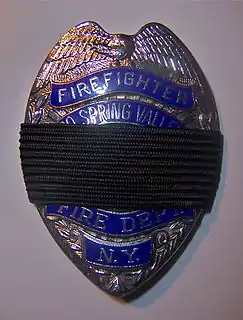Line of duty death
A line of duty death (LODD) is a death in the fire service or the police service while on duty at an emergency or drill. On average, there are more than 100 LODDs in the United States per year.[1] When a fire department loses a member in a LODD, it will commonly fly its flag at half-staff, and members will cover their badges with a mourning band. The New York City Fire Department has a tradition of announcing deaths with four series of five bells (the four fives, 5-5-5-5).[2]

Statistics
All statistics[1]
- The leading cause of fatalities of firefighters is heart attack (44%), followed by trauma (27%), motor vehicle collisions (20–25%) asphyxia and burns (20%). Asphixia and burns generally affect firefighters under 35 years of age more than stress or heart attacks, whereas the opposite is true for firefighters over 35 years of age.
- Full-time and career firefighters accounted for 33% of fatalities, but only 26% of the fire service.
- Where fire departments have EMS, calls related to this service may account for as much as 80% of call volume and as low as 50%. However, fatalities associated with these calls are very insignificant (3%).
- Volunteer firefighters account for 85% of en route fatalities.
- In the past decade, fatalities during training have risen to 6%.
- About 8% of fatalities occur at incidents with more than one LODD.
Prevention
While the complexity of firefighting is increasing, due to everything from cars to chemicals, the number of LODDs is trending downward, as the 1980-2015 mortality chart below illustrates. This declining firefighting death rate is particularly noteworthy considering the fact that from 1980 to 2015 our country's population grew from 236,542,000 to 321,419,000 – a 36% increase. Doubtless, a similar growth occurred in the number of our country's structures – and the size of our firefighter cadre. Yet during this timeframe, the number of annual firefighter deaths in 2015 is half the number who died in 1980.
Another factor is that a large number of LODDs – motor vehicle collisions – are preventable.[3]
L.O.D. Deaths present–1980
| Year | Number of Deaths |
|---|---|
| 2015 | 70 |
| 2014 | 87 |
| 2013 | 101 |
| 2012 | 83 |
| 2011 | 81 |
| 2010 | 87 |
| 2009 | 93 |
| 2008 | 118 |
| 2007 | 118 |
| 2006 | 107 |
| 2005 | 115 |
| 2004 | 119 |
| 2003 | 113 |
| 2002 | 101 |
| 2001 | 105/448** |
| 2000 | 105 |
| 1999 | 114 |
| 1998 | 93 |
| 1997 | 100 |
| 1996 | 99 |
| 1995 | 103 |
| 1994 | 106 |
| 1993 | 81 |
| 1992 | 77 |
| 1991 | 108 |
| 1990 | 108 |
| 1989 | 119 |
| 1988 | 136 |
| 1987 | 131 |
| 1986 | 121 |
| 1985 | 126 |
| 1984 | 119 |
| 1983 | 113 |
| 1982 | 126 |
| 1981 | 135 |
| 1980 | 140 |
** The 2001 figure includes the 343 FDNY firefighters who were killed in the line of duty at the World Trade Center on September 11, 2001.
References
- U.S. Fire Administration. Firefighter Fatalities Historical Overview Archived 2009-11-18 at the Wayback Machine
- "Tributes to Firefighters". Iowa Firefighters Association. Retrieved 3 February 2016.
When a firefighter died ... headquarters would transmit five bell strikes, repeated in four series, with a slight pause between each series, followed by the announcement
- "LODD Prevention. A Lesson in Vehicle Maintenance and Safety". Loddprevention.com. Archived from the original on 2012-02-24. Retrieved 2012-05-17.